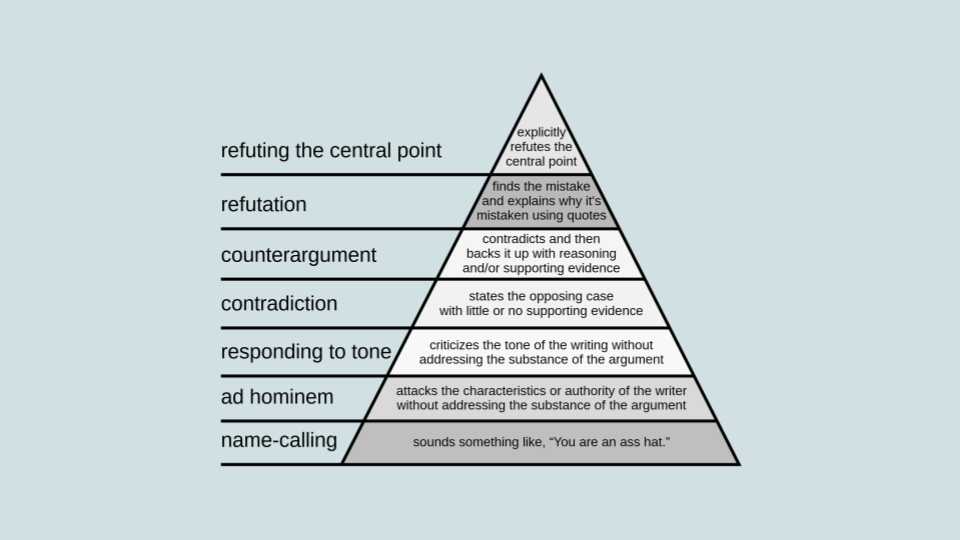We consume an inordinate amount of information, whether it’s blog posts, podcasts, social media content, online videos — a constant stream of data and claims we need to process and assess. When you are pressed for time, how can you quickly tell the difference between a strong argument and a weak argument, and why does it matter?
Some weak arguments are more obvious than others. Displays of certitude with little substance are often a tell-tale sign. Michel de Montaigne, one of the most prominent philosophers of the French Renaissance, wrote: “He who establishes his argument by noise and command shows that his reason is weak.”
But other weak arguments can be disguised behind a cloak of seemingly sound statements. For instance, the progression from one point to another seems logical up to a point, but breaks down before managing to provide sufficient support for the conclusion. Let’s have a look at how you can quickly spot these, especially when you need to make a quick judgment.
The nature of a weak argument
Not all bad arguments are weak in nature. An argument can be bad because it is invalid. A classic example is solving a mathematical equation: if you made a mistake in the proof, it would not be considered “weak”, it would simply be invalid. Invalid arguments are often easier to spot because you just need to look for logical errors in the deductive process.
A bad argument can also be strong, but built on false premises. For instance, “Playing video games leads to violent behavior. This person plays a lot of video games, and therefore, they are likely to exhibit violent behavior.” The argument is strong, but it’s still bad, because the premise that playing video games is linked to violence is not true.
So what exactly is a weak argument? You need two ingredients.
- Inductive reasoning. The argument should move from specific observations to broad generalizations.
- Uncertain premise. The specific observations used to build the argument should either have a low probability or be based on personal opinions rather than facts.
Even if the argument sounds logical, the conclusions follow neither with certainty nor with high probability, and it means you are faced with a weak argument.
Here is an example of weak argument: “Charlie is a woman. Some women like poetry. Therefore, Charlie likes poetry.” In this case, the premise “some women like poetry” has a low or unclear probability, so the argument is weak. Or the weak argument can be based on a personal opinion rather than a fact: “Charlie is a woman. Most women hate mathematics. Therefore, Charlie hates mathematics.”
You may not always have the time to apply all the mental gymnastics to figure out whether an argument is strong or weak, but luckily there are some mental models you can apply to quickly analyze arguments, especially when consuming longer pieces of content.
How to quickly spot weak arguments
While philosophers have devised many methods to evaluate the quality of arguments, there are three critical thinking tools you can use to quickly distinguish a weak argument from a strong argument.
- Look for arguments using the “surely” operator. In his book Intuition Pumps and Other Tools for Thinking, philosopher Daniel C. Dennett explains: “The word surely is as good as a blinking light locating a weak point in the argument (…) It marks the very edge of what the author is actually sure about and hopes readers will be sure about.” While it’s not always an indicator for a weak argument, it is still a sign that you need to consider the statement with healthy skepticism. This works with similar words such as obviously, evidently, etc.
- Compare the conclusion of the argument to a coin toss. If you are better off throwing a coin to know if the conclusion is true, the argument is weak. For instance: “About 50% of humans I met are female. Charlie is human. Therefore, Charlie is female.” In this case, even if the premise is true, you only have 50% chance for the conclusion to be true — you may as well toss a coin! Any argument based on a premise with a low or uncertain probability would not pass the coin toss test, and can be safely classified as a weak argument.
- Map the argument onto the pyramid of disagreement. In his essay How to Disagree, Paul Graham places types of argument into a seven-point hierarchy going from weakest to strongest. The weakest type of argument is name-calling, followed by Ad Hominem. Graham writes: “An ad hominem attack is not quite as weak as mere name-calling. It might actually carry some weight. For example, if a senator wrote an article saying senators’ salaries should be increased, one could respond: Of course he would say that. He’s a senator. This wouldn’t refute the author’s argument, but it may at least be relevant to the case. It’s still a very weak form of disagreement, though. If there’s something wrong with the senator’s argument, you should say what it is; and if there isn’t, what difference does it make that he’s a senator?” The hierarchy of disagreement can help you spot weak arguments.
The “surely” operator, the coin toss test, and the hierarchy of disagreement are three simple tools to add to your thinking toolbox. Use them whenever you are reading a long argumentative essay to quickly spot potential weak arguments, or at least to know that your alarm bells should go off and that you should tread with healthy caution.

